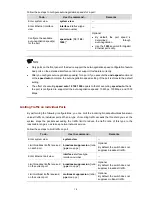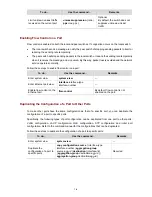
1-5
Aggregation Group Categories
Depending on whether or not load sharing is implemented, aggregation groups can be load-sharing or
non-load-sharing aggregation groups. When load sharing is implemented,
z
For IP packets, the system will implement load-sharing based on source IP address and
destination IP address;
z
For non-IP packets, the system will implement load-sharing based on source MAC address and
destination MAC address.
In general, the system only provides limited load-sharing aggregation resources, so the system needs
to reasonably allocate the resources among different aggregation groups.
The system always allocates hardware aggregation resources to the aggregation groups with higher
priorities. When load-sharing aggregation resources are used up by existing aggregation groups,
newly-created aggregation groups will be non-load-sharing ones.
Load-sharing aggregation resources are allocated to aggregation groups in the following order:
z
An aggregation group containing special ports which require hardware aggregation resources has
higher priority than any aggregation group containing no special port.
z
A manual or static aggregation group has higher priority than a dynamic aggregation group (unless
the latter contains special ports while the former does not).
z
For aggregation groups, the one that might gain higher speed if resources were allocated to it has
higher priority than others. If the groups can gain the same speed, the one with smallest master
port number has higher priority than other groups.
When an aggregation group of higher priority appears, the aggregation groups of lower priorities
release their hardware resources. For single-port aggregation groups, they can transceive packets
normally without occupying aggregation resources
z
A load-sharing aggregation group contains at least two selected ports, but a non-load-sharing
aggregation group can only have one selected port at most, while others are unselected ports.
z
When more than eight load-sharing aggregation groups are configured on a single switch, fabric
ports cannot be enabled on this switch.
z
When no more than eight load-sharing aggregation groups are configured on a single switch, fabric
ports can be enabled on this switch. The aggregation groups added subsequently are all
non-load-sharing aggregation groups. If the fabric ports are disabled, the state of these
non-load-sharing aggregation groups will not be changed automatically. These non-load-sharing
aggregation groups will become load-sharing aggregation groups only after the unselected ports in
these aggregation groups are unplugged and then plugged or the
shutdown
command and then
the
undo shutdown
command are executed.
















































